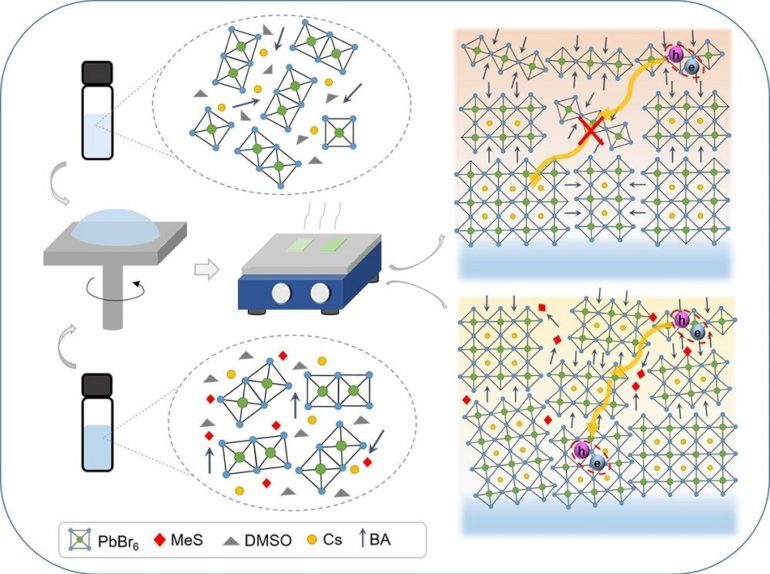Energy efficient light-emitting diodes (LEDs) have been used in our everyday life for many decades. But the quest for better LEDs, offering both lower costs and brighter colors, has recently drawn scientists to a material called perovskite. A recent joint-research project co-led by the scientist from City University of Hong Kong (CityU) has now developed a 2-D perovskite material for the most efficient LEDs.
From household lighting to mobile phone displays, from pinpoint lighting needed for endoscopy procedures, to light source to grow vegetables in Space, LEDs are everywhere. Yet current high-quality LEDs still need to be processed at high temperatures and using elaborated deposition technologies—which makes their production cost expensive.
Scientists have recently realized that metal halide perovskites—semiconductor materials with the same structure as calcium titanate mineral, but with another elemental composition—are extremely promising candidate for next generation LEDs. These perovskites can be processed into LEDs from solution at room temperature, thus largely reducing their production cost. Yet the electro-luminescence performance of perovskites in LEDs still has a room for improvements.
Led by Professor Andrey Rogach, Chair Professor at the Department of Materials Science and Engineering at CityU, and his collaborator Professor Yang Xuyong from Shanghai University, the team has found a kind of dimmer switch: they could turn one light emission from perovskites to a brighter level!
They worked with two-dimensional (2-D) perovskites (also known as Ruddlesden Popper perovskites) and succeeded to realize very efficient and bright LEDs, with best reported performance on both current efficiency and external quantum efficiency for devices based on this kind of perovskites. This work has now put the perovskite LEDs close on the heels of current commercial display technologies, such as organic LEDs.
Their findings were published in the scientific journal Nature Communications, titled “Smoothing the energy transfer pathway in quasi-2-D perovskite films using methanesulfonate leads to highly efficient light-emitting devices.”
The key to the powerful change lies in the addition of around 10% of a simple organic molecule called methanesulfonate (MeS).
In this study, the 2-D perovskites used by the team have a nanometre level thickness. The MeS reconstructs the structure of the 2-D perovskite nanosheets, while at the same time enhancing exciton energy transfer between sheets of different thicknesses. Both of these changes have greatly enhanced the electro-luminescence of the thicker, green-emitting perovskite sheets within the 2-D structure.
The MeS is also useful in reducing the number of defects in the 2-D perovskite structure. During the process of light production, where radiative recombination took place, part of the excitons that are required for the process will be “wasted” in the non-radiative recombination which produces no light. MeS reduces the number of uncoordinated Pb2+ cations, the cause for excitons to undergo the non-radiative recombination, making sure more excitons participating in light production.
The results of the research for producing better LEDs has been encouraging. Brightness of 13,400 candela/m2 at a low applied voltage of 5.5 V, and external quantum efficiency of 20.5% are recorded. This is close to the maximum that can be achieved by many existing LED technologies, and has almost doubled the external quantum efficiency level of 10.5% reported in their previous study two years ago.
“My CityU team has built-up its expertise on perovskite materials to a very high level in a relatively short period of time, thanks to funding support from Senior Research Fellowship by the Croucher Foundation. And already we are seeing the benefit, especially in the outcomes detailed in this latest publication,” said Professor Rogach.
“The high brightness, excellent color purity, and commercial grade operating efficiency that has been achieved marks 2-D perovskites as an extremely attractive materials for future commercial LEDs, and potentially also display technology. It’s a tangible outcome from both fundamental and applied research into novel nano-scale materials” he adds.
Blue light means big progress for perovskite-based LEDs
More information:
Lingmei Kong et al. Smoothing the energy transfer pathway in quasi-2D perovskite films using methanesulfonate leads to highly efficient light-emitting devices, Nature Communications (2021). DOI: 10.1038/s41467-021-21522-8
Provided by
City University of Hong Kong
Citation:
Producing highly efficient LEDs based on 2D perovskite films (2021, March 10)
retrieved 15 March 2021
from https://techxplore.com/news/2021-03-highly-efficient-based-d-perovskite.html
This document is subject to copyright. Apart from any fair dealing for the purpose of private study or research, no
part may be reproduced without the written permission. The content is provided for information purposes only.



